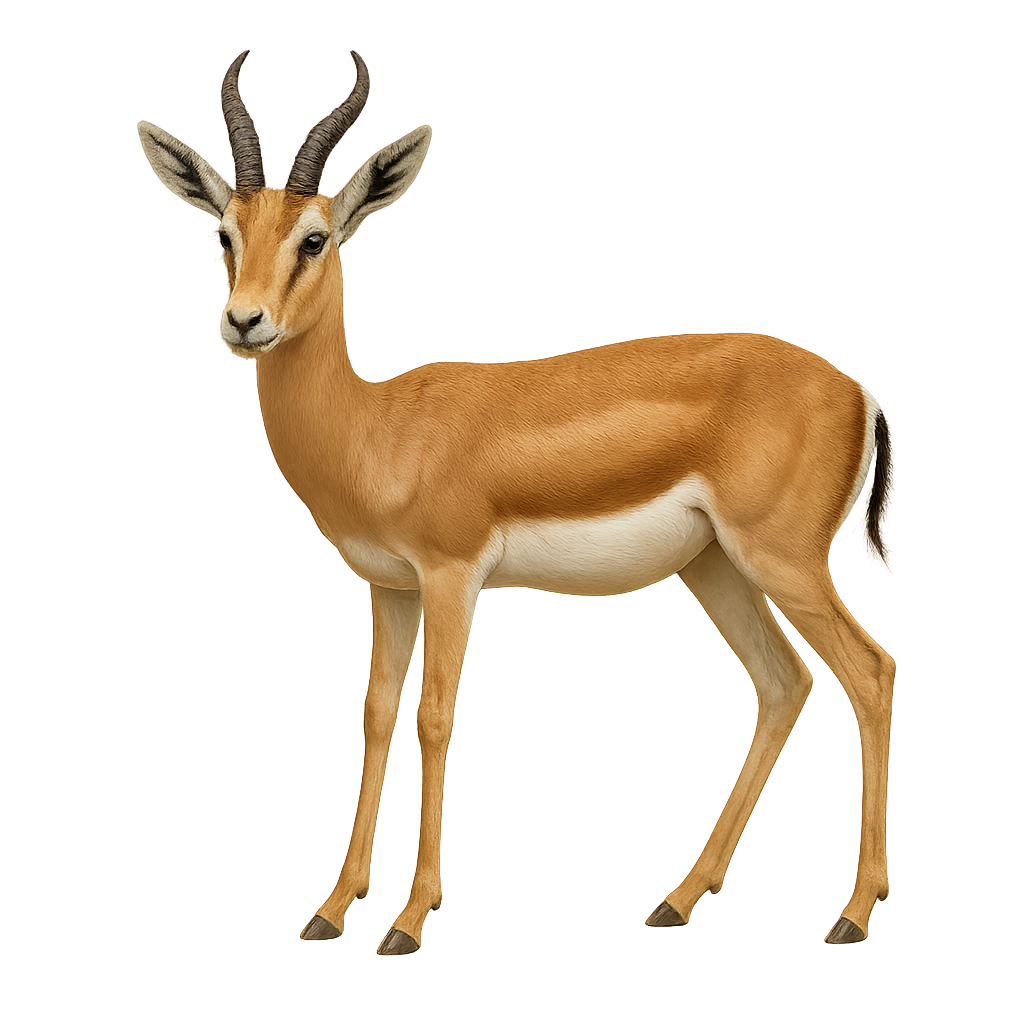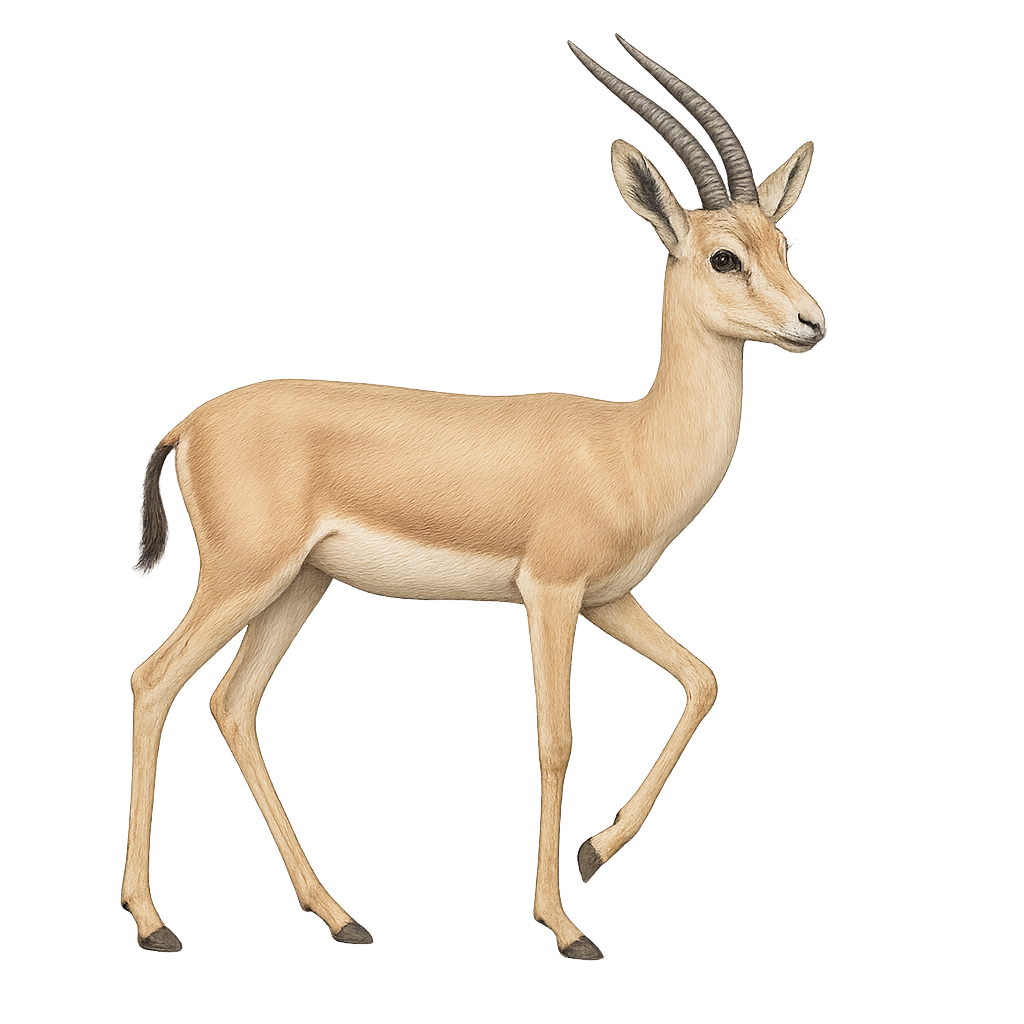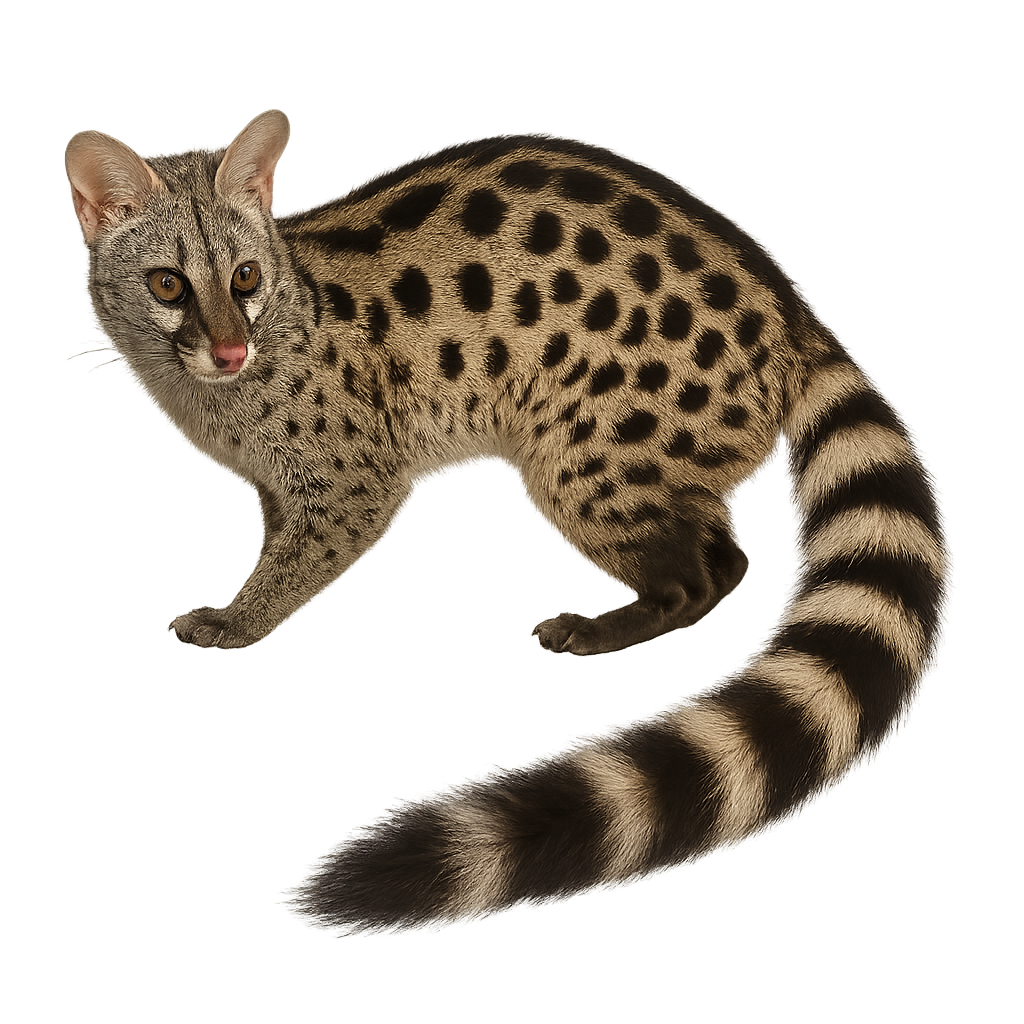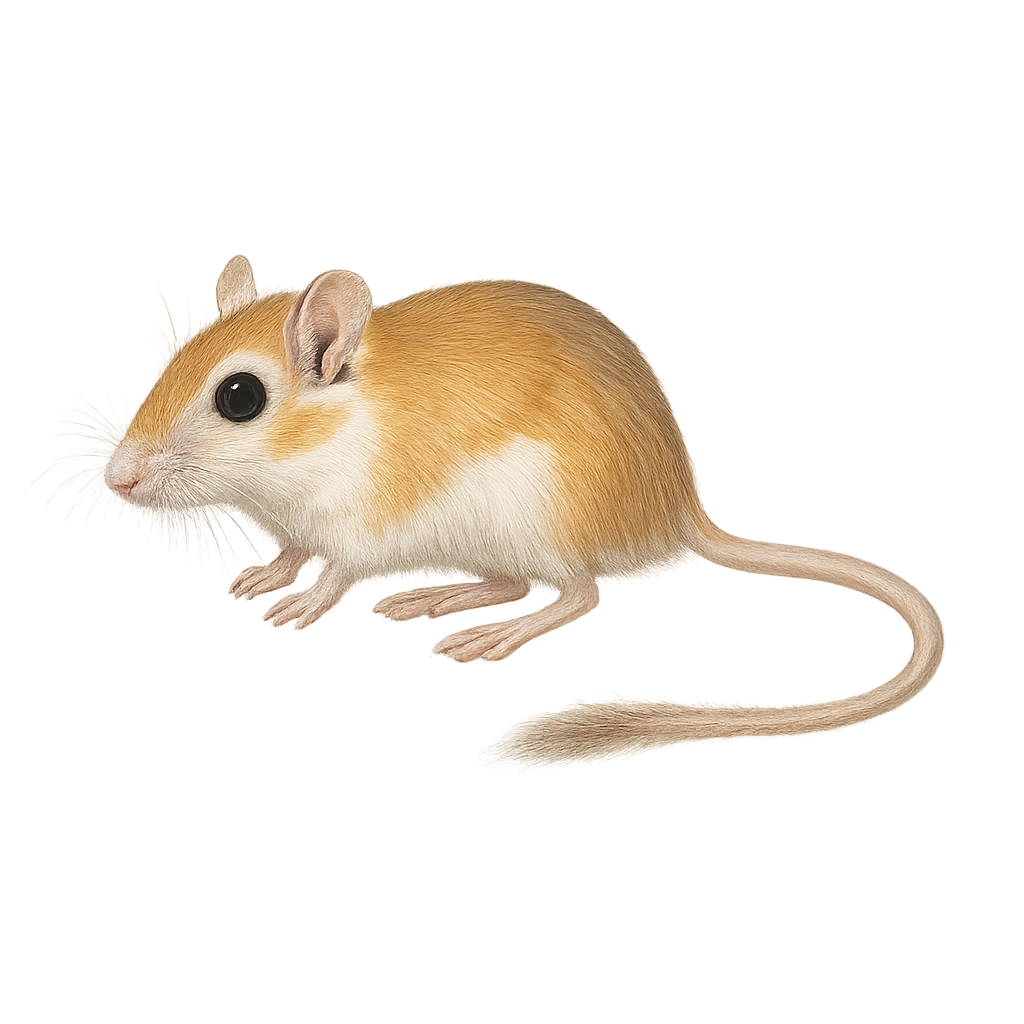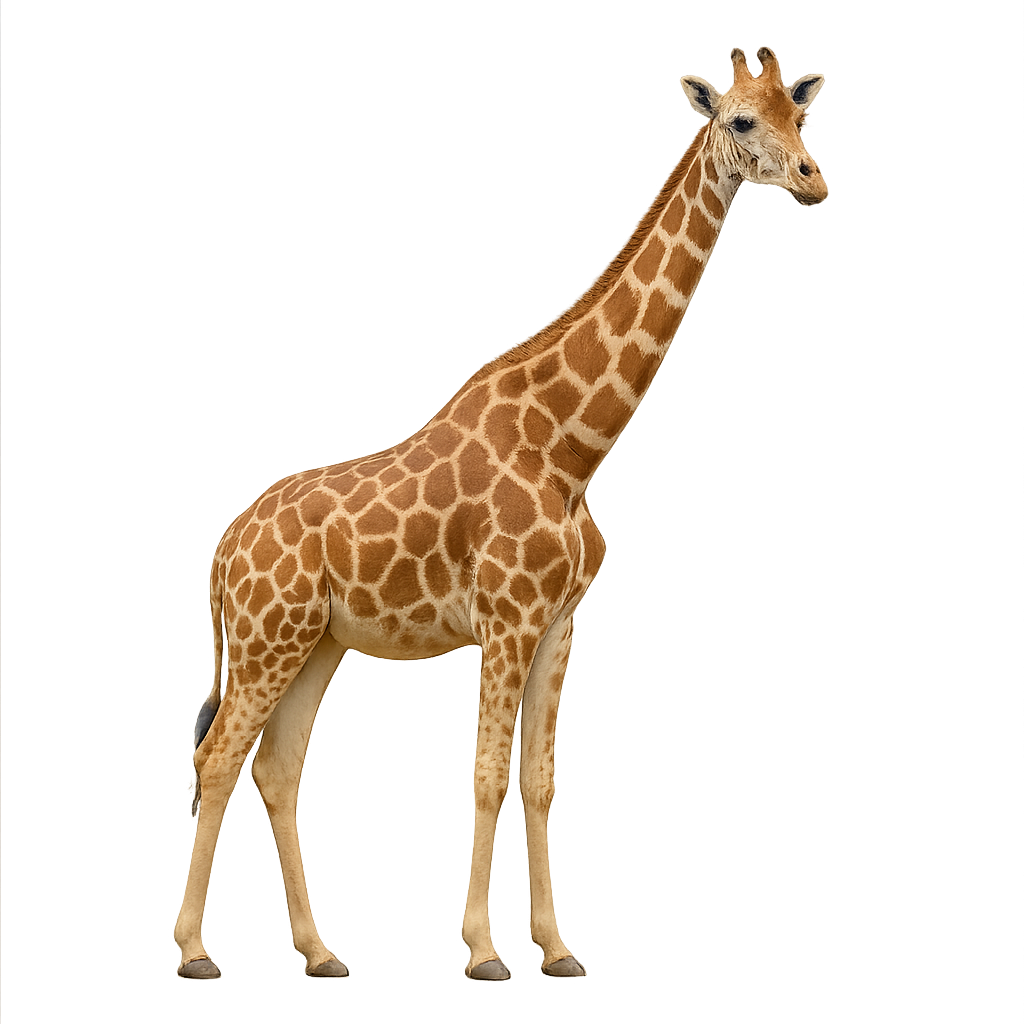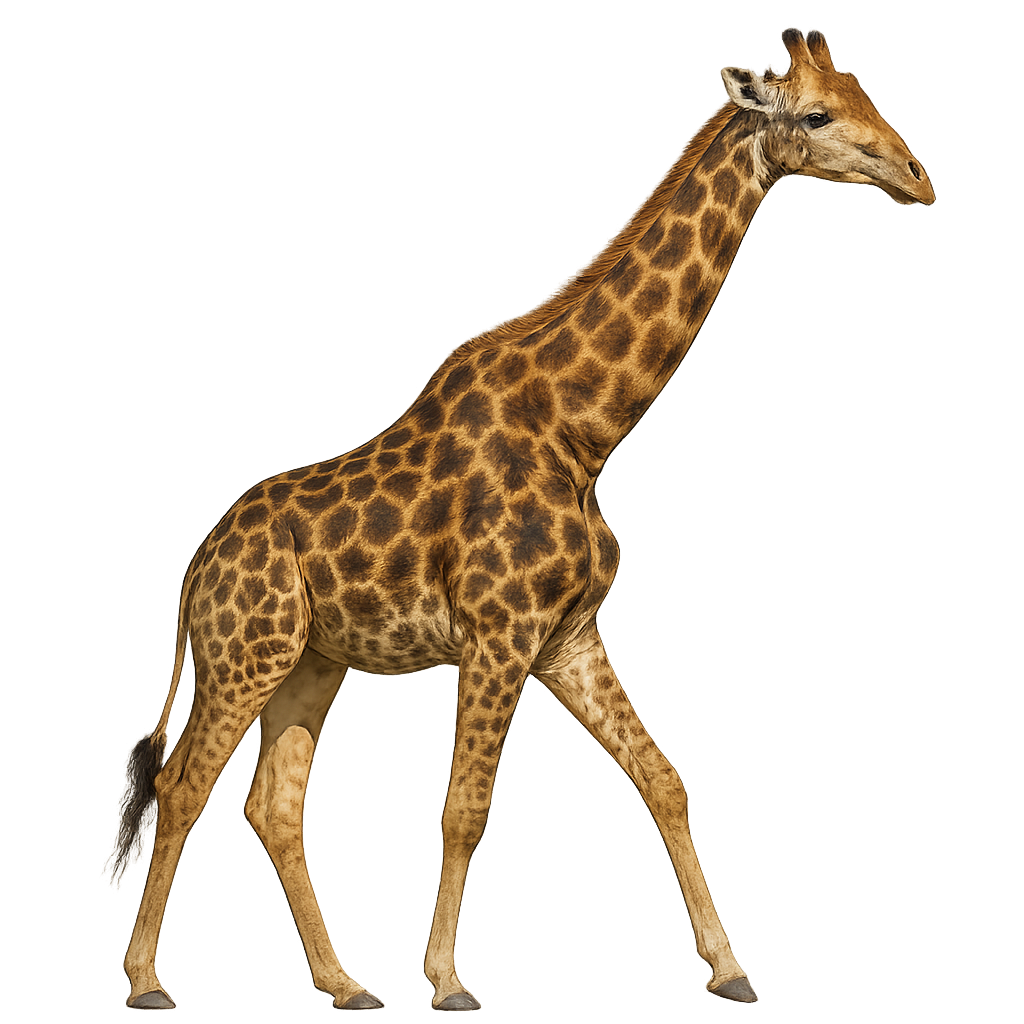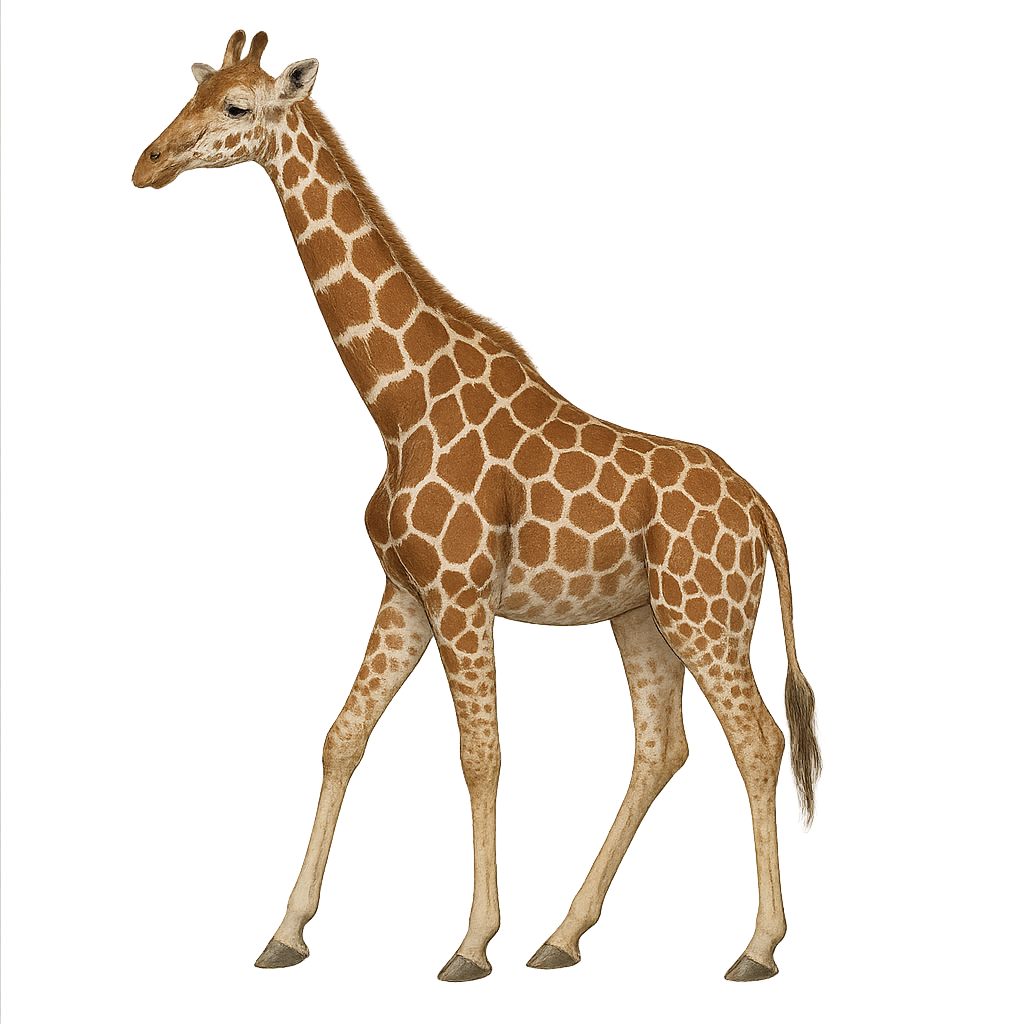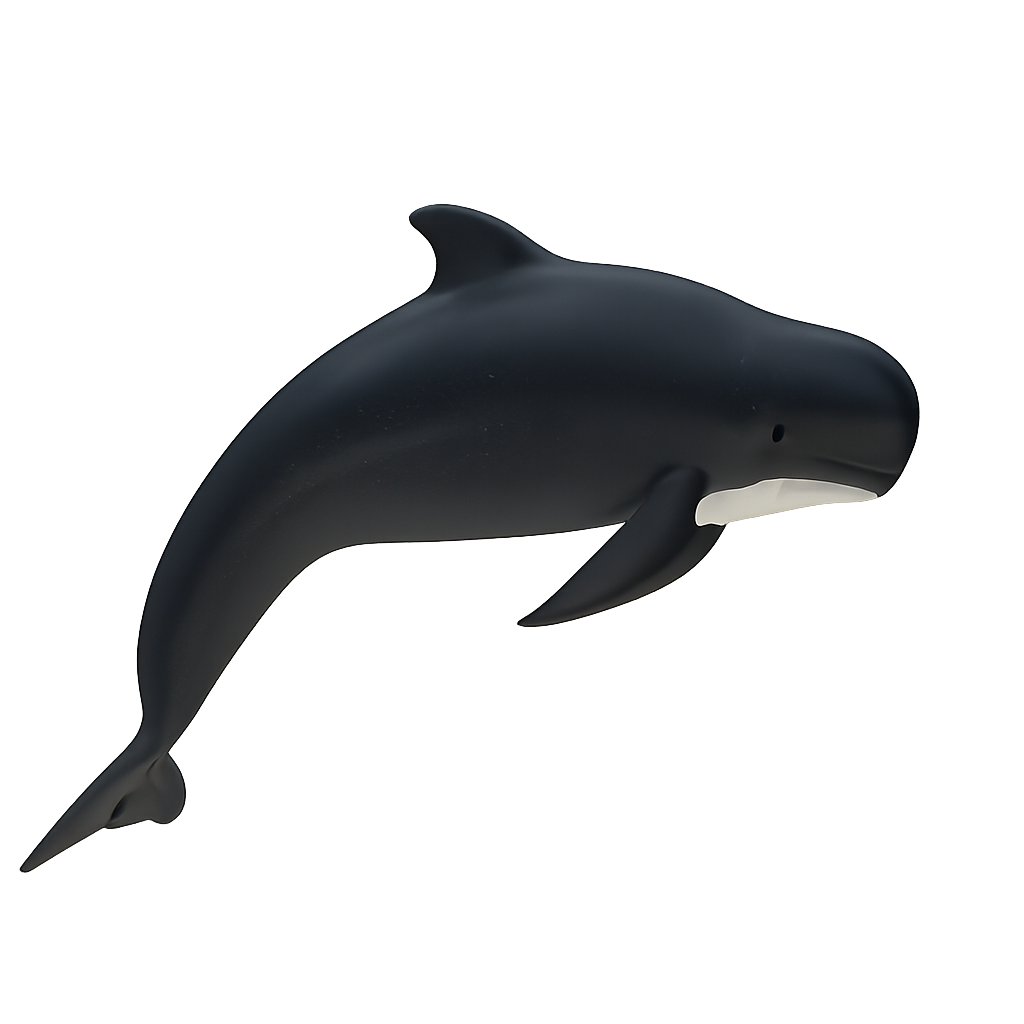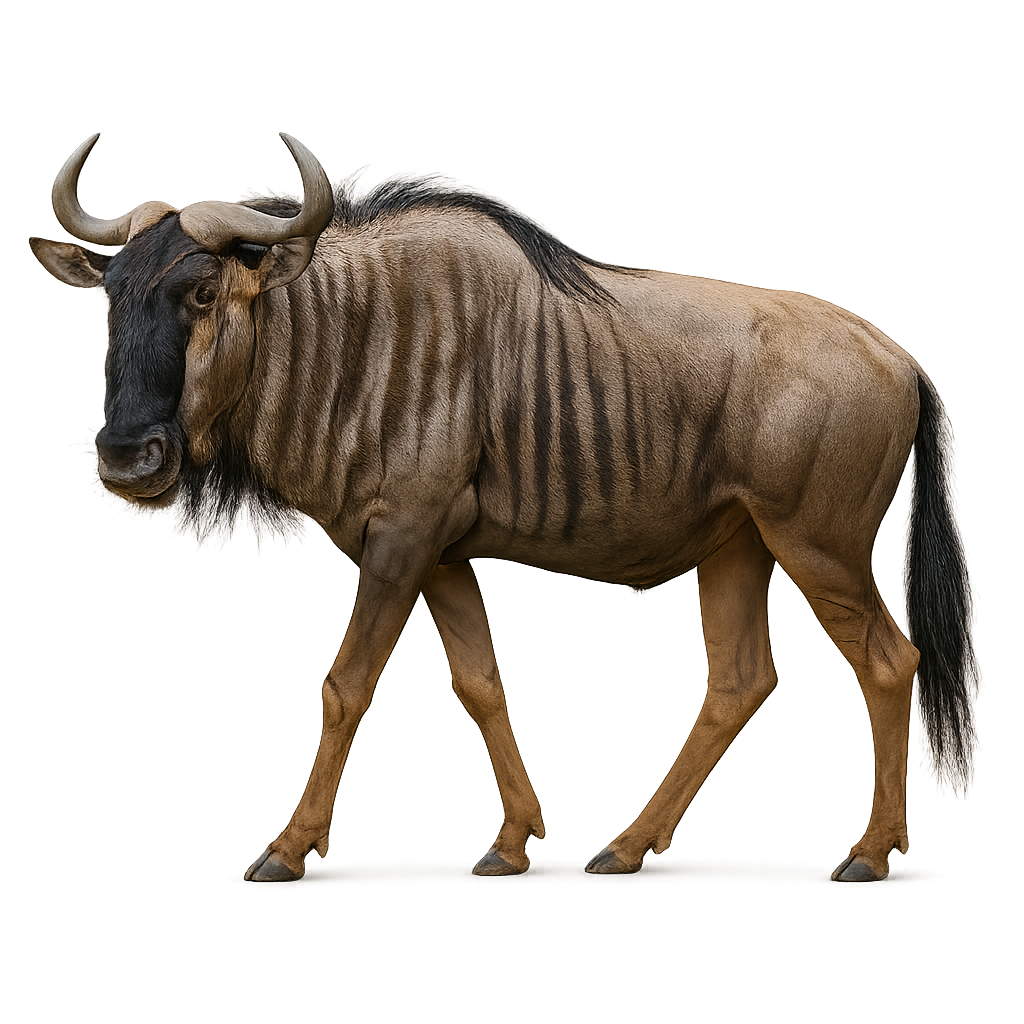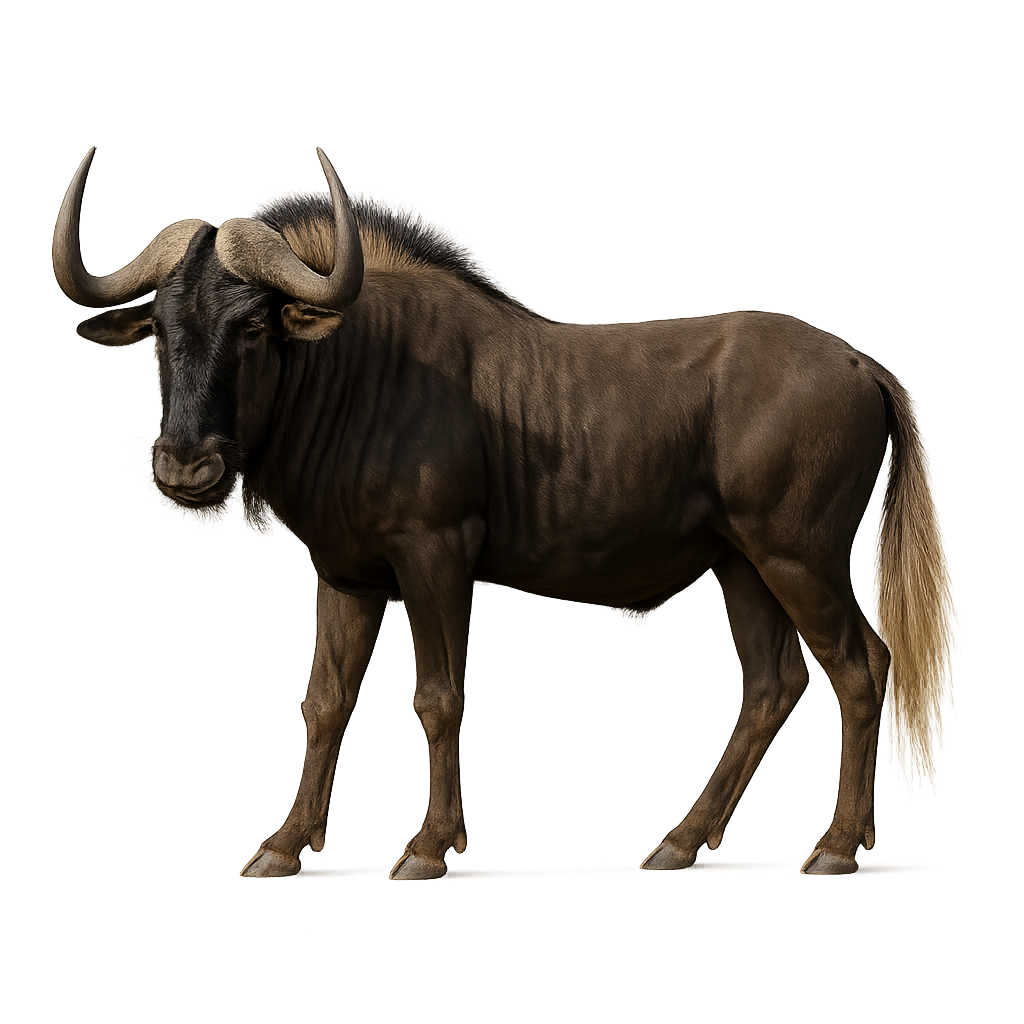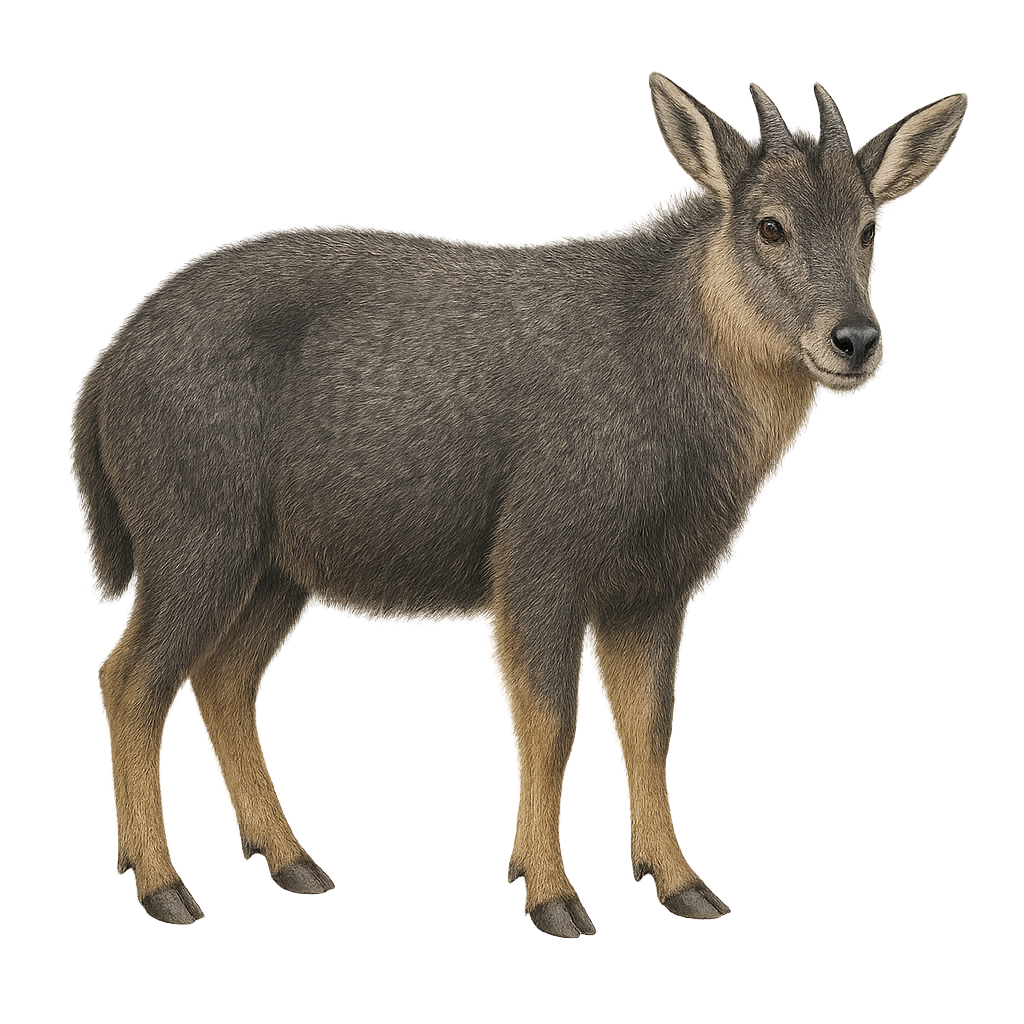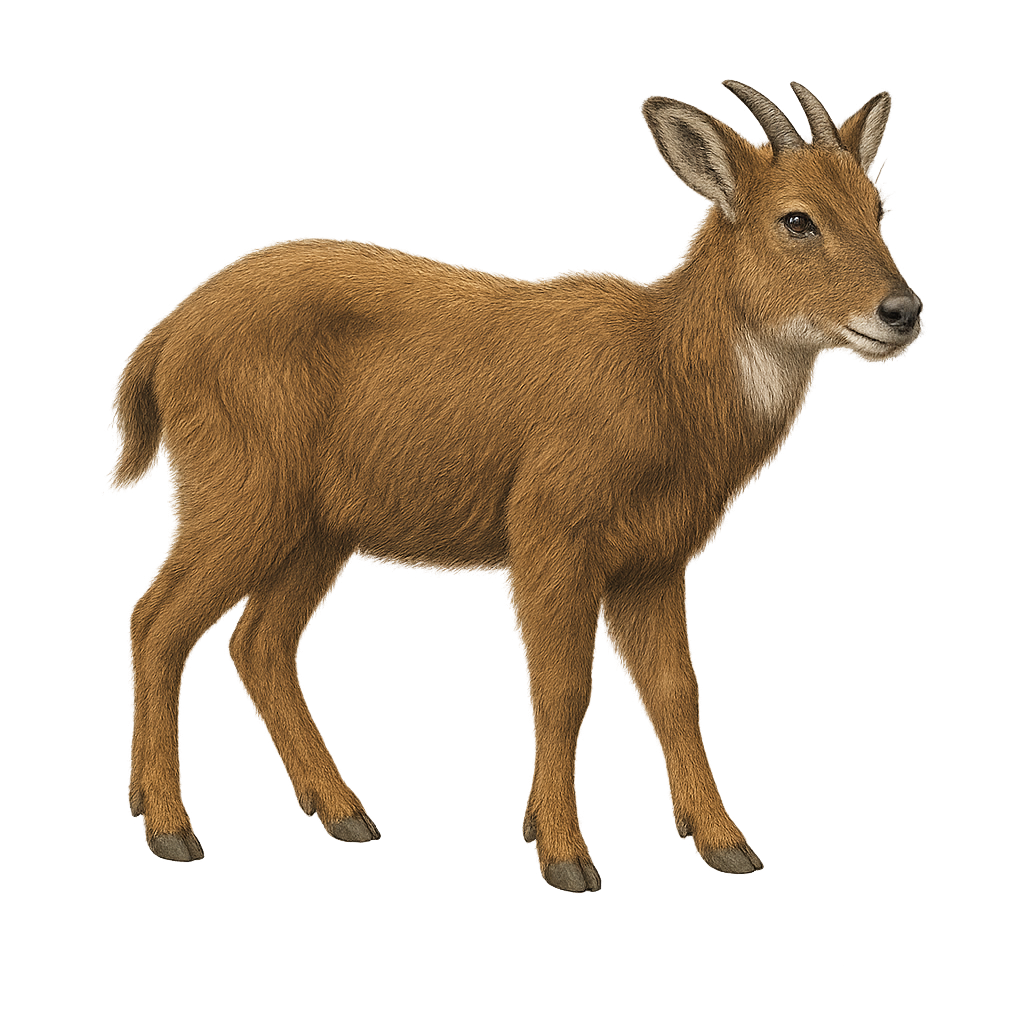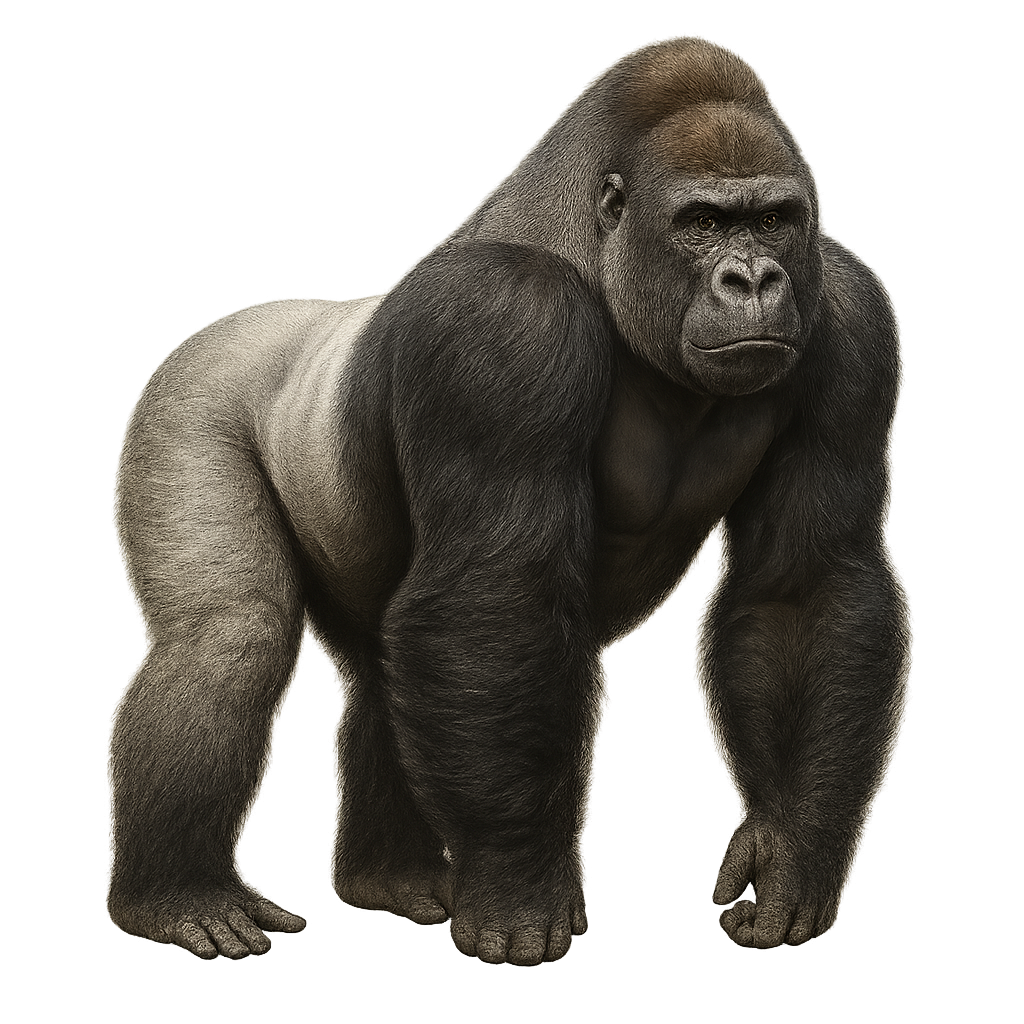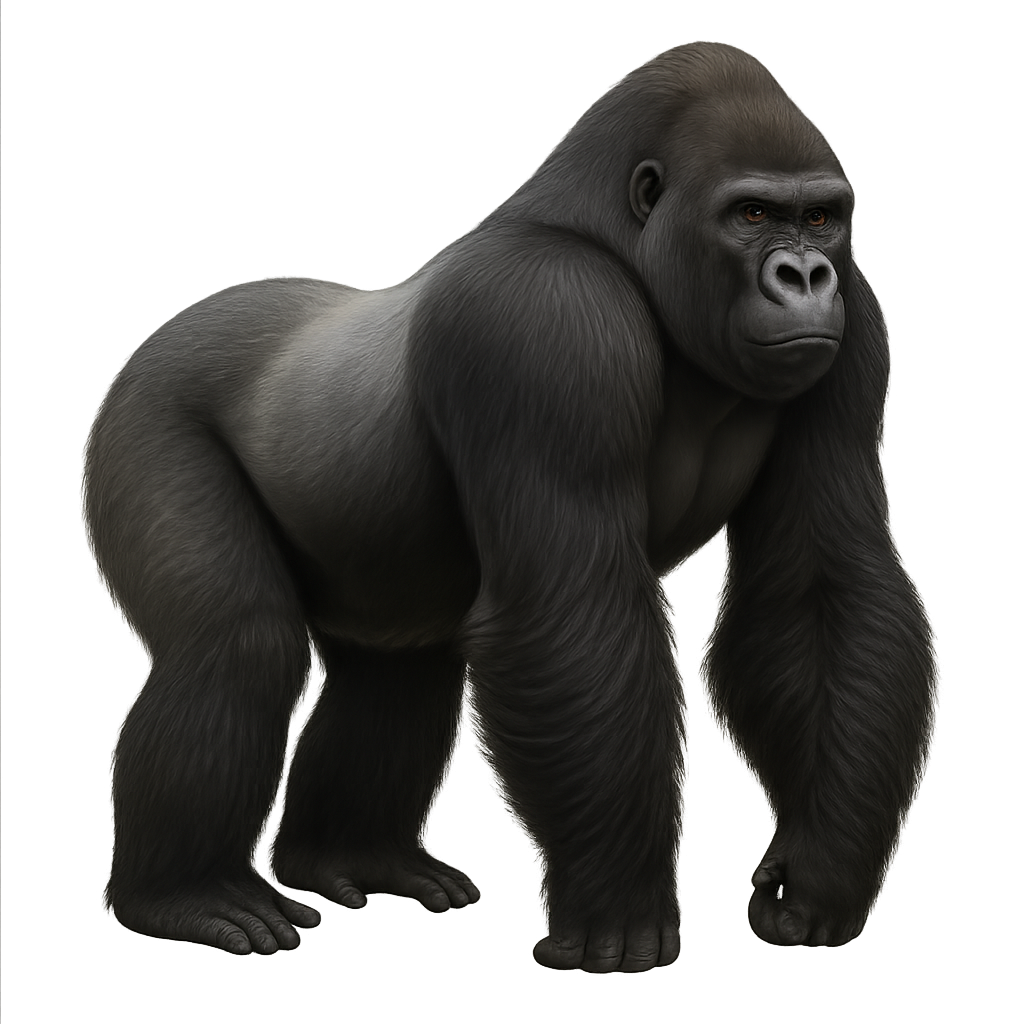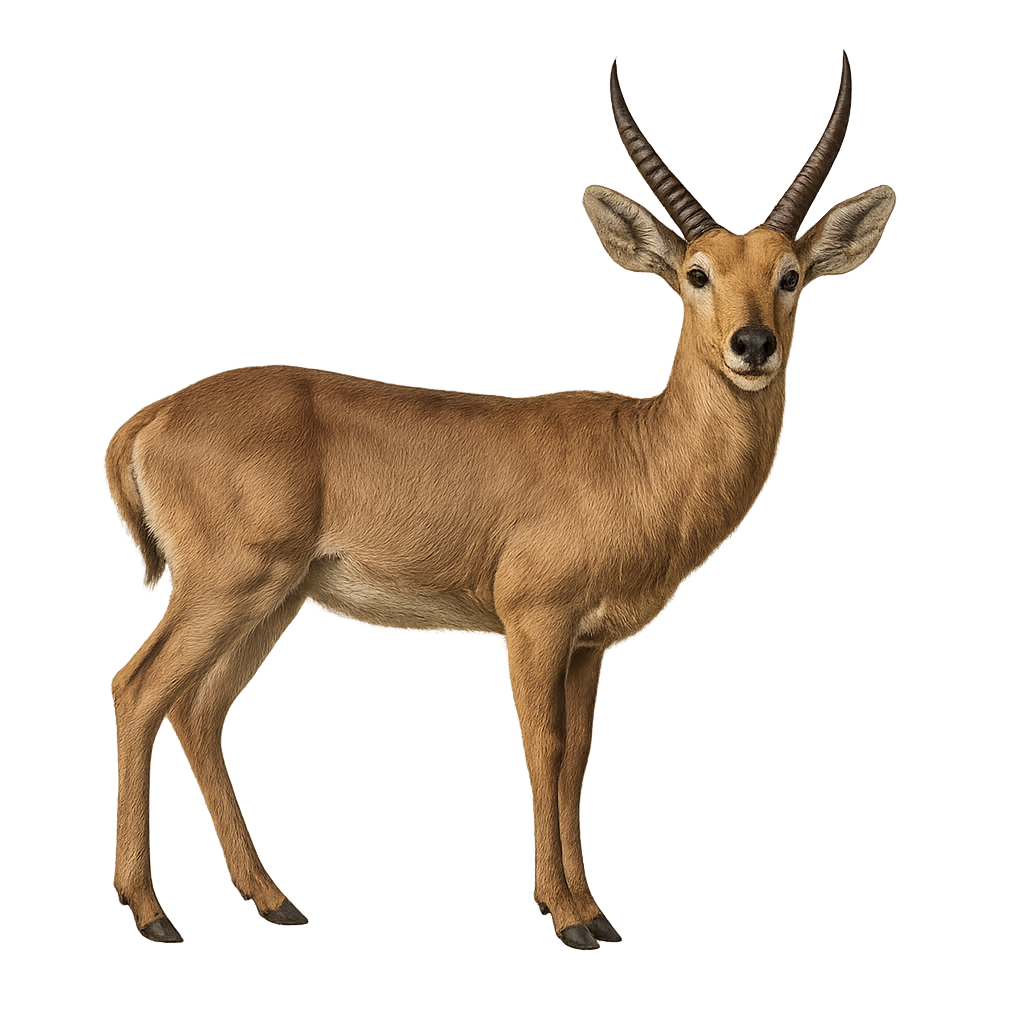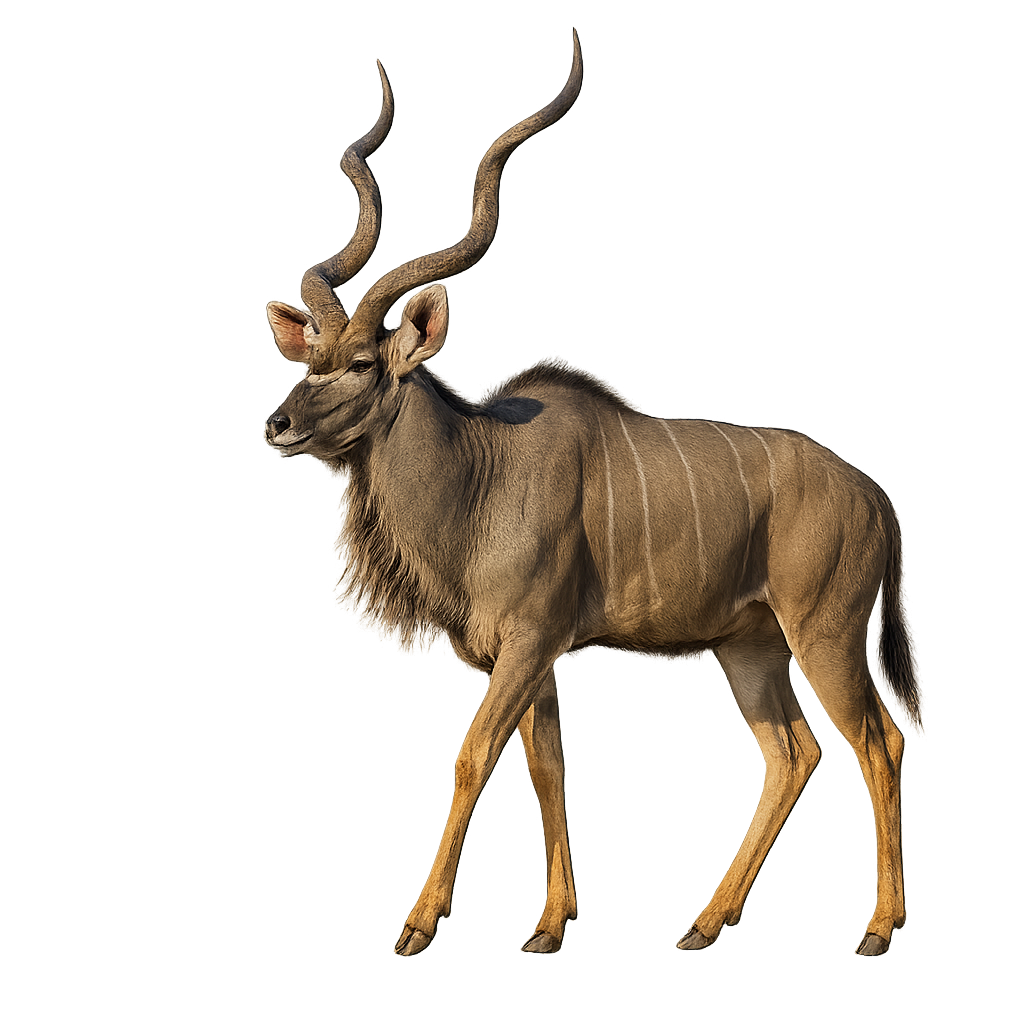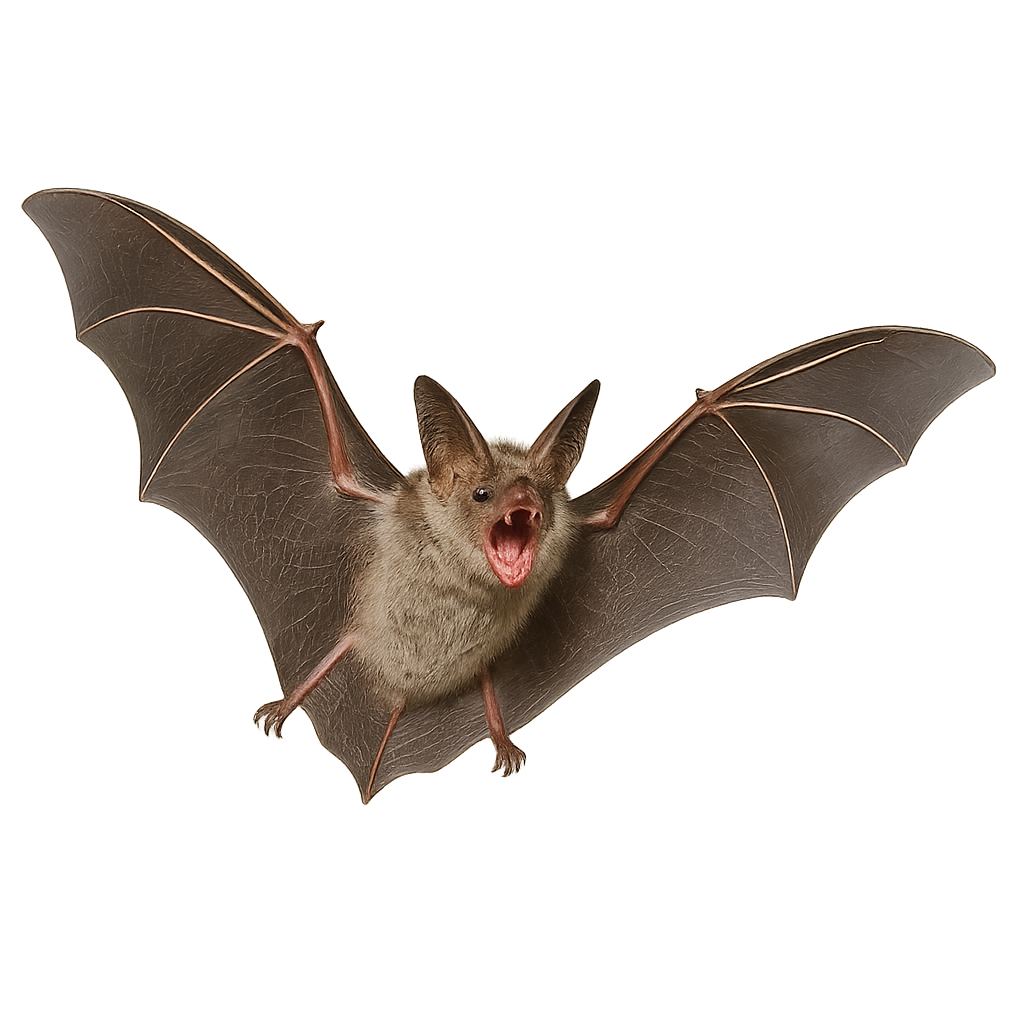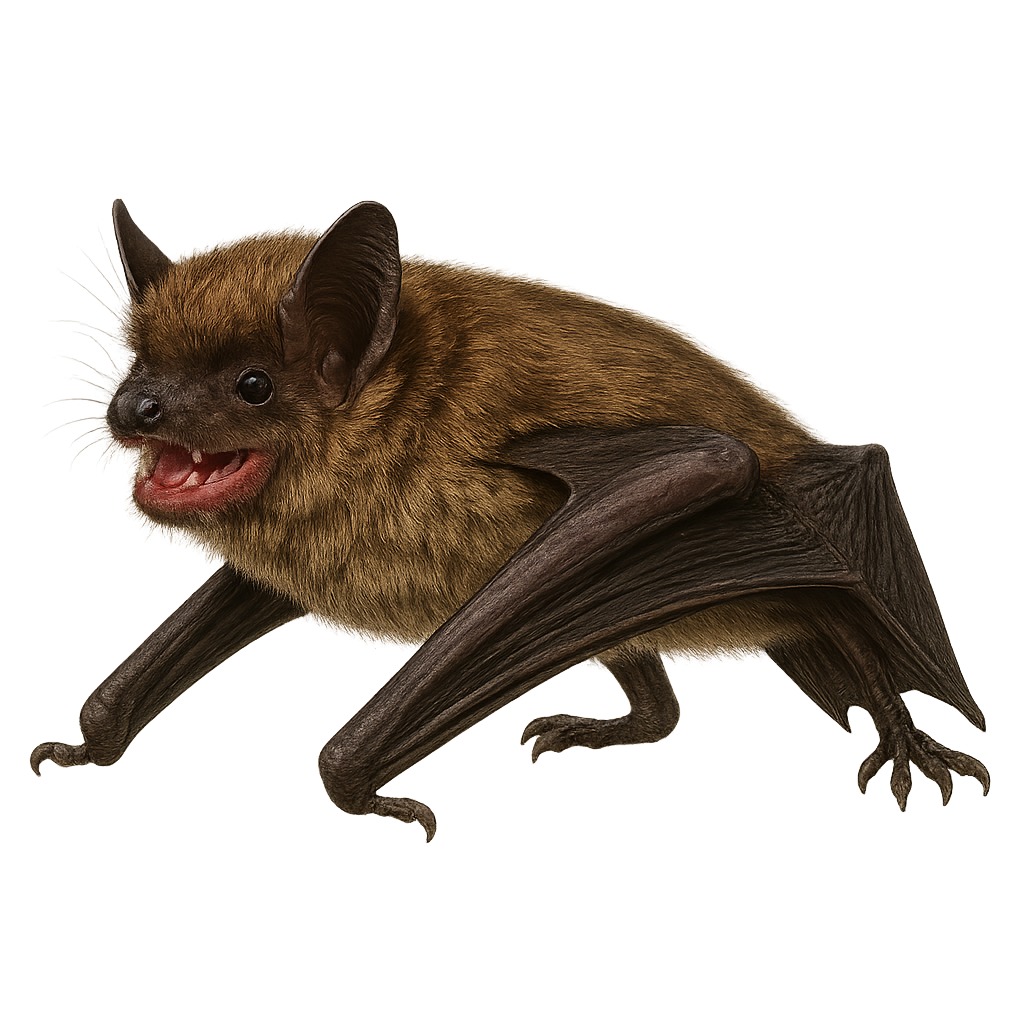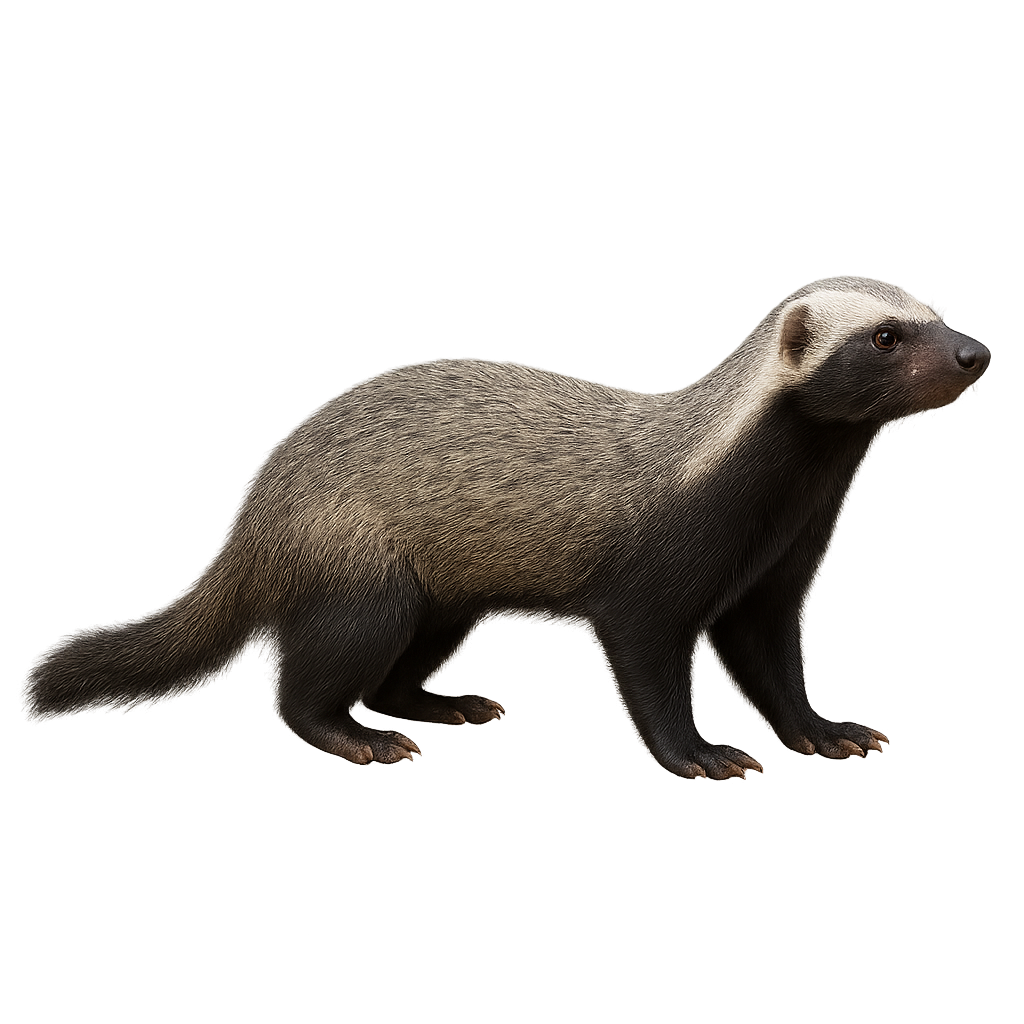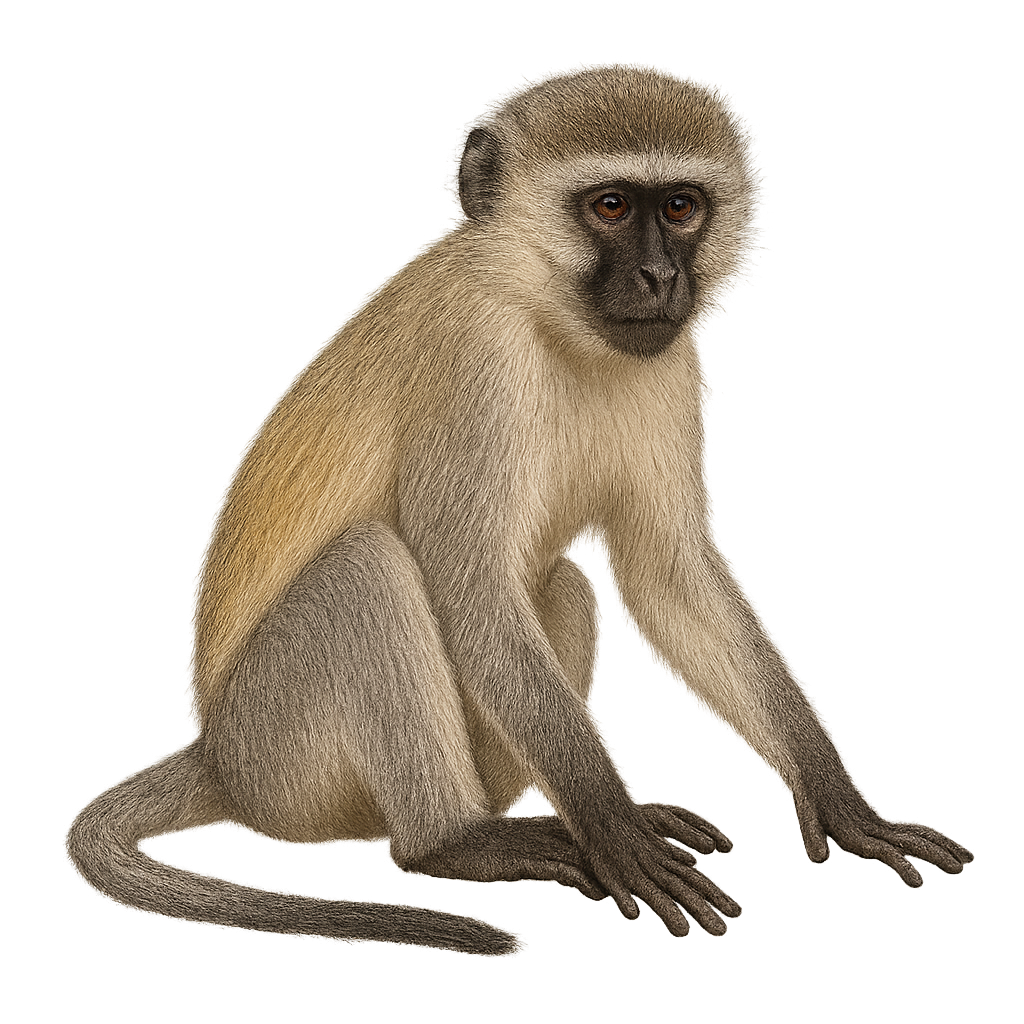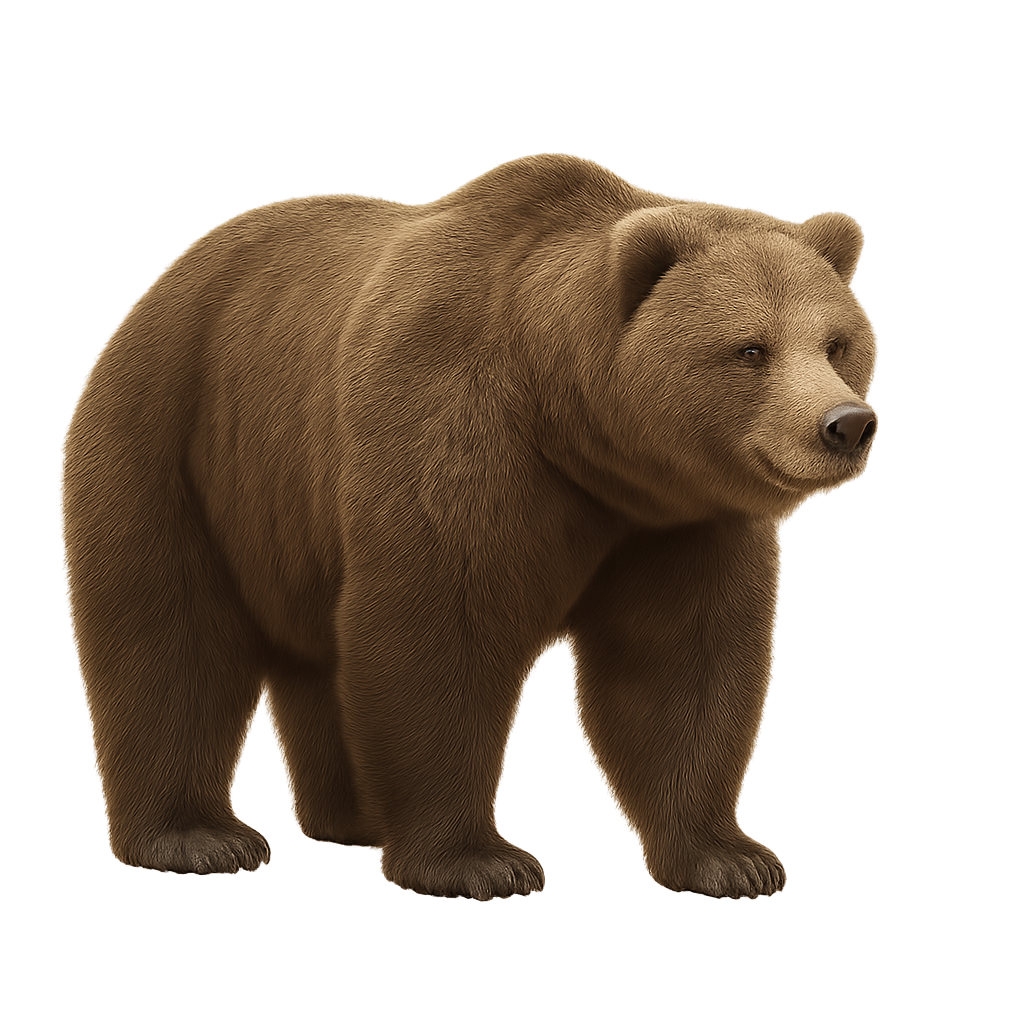The Dorcas gazelle is a small, graceful antelope well adapted to the arid environments of the Sahara and surrounding regions. It is distinguished by its light beige coat, which allows it to blend into the desert, and its elegantly curved horns. Standing about 55 to 65 cm at the shoulder and weighing between 15 and 20 kg, it is agile and fast, capable of running at high speeds to escape predators. Its diet mainly consists of leaves, flowers, and fruits, enabling it to survive in areas where water is scarce. The Dorcas gazelle is a symbol of grace and resilience in extreme conditions.
The slender-horned gazelle, or Gazella leptoceros, is a species of gazelle that primarily inhabits the desert regions of the Sahara. It is recognizable by its slender, elongated horns, which can reach up to 40 cm in length. Its coat is pale, almost white, allowing it to blend into the sandy dunes. This gazelle is well adapted to its arid environment, capable of surviving with very little water, feeding mainly on leaves, shoots, and fruits. Unfortunately, it is critically endangered due to excessive hunting and habitat degradation.
The Common Genet is a small, agile, and elegant carnivore, easily recognizable by its long and slender body, as well as its characteristic spots. It measures between 45 and 60 cm in length, with a tail measuring 40 to 50 cm, and typically weighs between 1.5 and 2.5 kg. Its coat is usually light gray or brown, speckled with dark spots that form a distinctive pattern on its back and flanks. The Common Genet has a bushy tail and a body shape that allows it to easily climb trees and slip into narrow spaces. It primarily inhabits forests, woodlands, and wooded areas in North and South Africa, as well as the Iberian Peninsula. This carnivore is omnivorous, feeding mainly on small mammals, birds, insects, fruits, and berries. The Common Genet is also an excellent climber, often seen moving through trees in search of food or to escape danger. While the Genet is not currently threatened, it faces threats related to habitat loss and human persecution.
The Lesser Egyptian Jerboa, or Gerbillus gerbillus, is a small desert rodent primarily found in the arid regions of North Africa. It is well adapted to its dry environment due to its ability to conserve water and its nocturnal habits, which help it avoid the daytime heat. Its fur is typically sandy, providing excellent camouflage in its natural habitat. It primarily feeds on seeds, insects, and desert vegetation. The Lesser Egyptian Jerboa is known for its long hind legs, which allow it to make large jumps, facilitating quick movements to escape predators. Although often solitary, it can sometimes be seen in small groups.
The Gerenuk is a unique species of antelope from East Africa, recognizable by its long neck and graceful posture. It lives in savannas and semi-deserts, where it primarily feeds on shrubs and tree leaves. The Gerenuk is an excellent climber, capable of standing on its hind legs to reach high vegetation. This ability allows it to feed efficiently and avoid competition with other ground-dwelling herbivores. Although relatively discreet, the Gerenuk is threatened by habitat loss and poaching.

Gibbonss, members of the Hylobatidae family, are primates particularly known for their agility and their ability to move through the canopy. They are the smallest of the great apes, measuring between 40 and 70 cm in height, with long, powerful arms that can reach up to 2.5 times the length of their body. Their weight typically ranges from 5 to 15 kg, depending on the species. Gibbonss are primarily known for their mode of locomotion called "brachiation," where they move by swinging from branch to branch at impressive speeds, often at high altitudes. Their fur is typically dense, varying in color from black to light brown, and some species have distinct facial markings. Gibbonss primarily inhabit the tropical forests of Southeast Asia, where they feed mainly on fruits, leaves, and small insects. These primates are social and typically live in small family groups. While gibbons are not all at immediate risk, several species are endangered due to habitat loss, poaching, and the illegal wildlife trade.
The Maasai Giraffe is a subspecies of giraffe, easily recognized by its irregular and jagged patches, which differ from those of other subspecies. It typically stands between 4.3 and 4.8 meters tall, with males being larger and heavier than females, weighing between 800 and 1,200 kg. Its coat is light beige to light brown, with irregularly shaped leaf-like patches that are bordered in white. These patches are smaller and more scattered than those of the Southern Giraffe. The Maasai Giraffe primarily inhabits the savannas and grasslands of East Africa, particularly in Kenya and Tanzania. It is herbivorous, feeding mainly on acacia leaves and other tall vegetation, which it reaches with its long neck and prehensile tongue. Although the Maasai Giraffe is currently considered less threatened than other giraffe subspecies, it faces threats such as habitat loss and poaching.
The Northern Giraffe is a subspecies of giraffe, characterized by its slender body and long neck. It stands about 4.5 to 5.5 meters tall, with males being larger and bulkier than females. Northern giraffes weigh between 800 and 1,200 kg. Their coat is light beige with irregular patches of brown or orange, which are smaller and more closely spaced than those of other giraffe subspecies. These patches are outlined in white, creating a distinctive pattern. The Northern Giraffe primarily inhabits the savannas and open woodlands of northern Kenya, particularly in the Samburu National Reserve and surrounding areas. Herbivorous, it feeds mainly on acacia leaves and other tall vegetation, which it reaches with its long neck and prehensile tongue. The Northern Giraffe is an endangered species, due to habitat loss and human conflicts, including poaching and encroachment on its land.
The Southern Giraffe is a subspecies of giraffe, characterized by its slender body, long neck, and robust legs. It typically stands between 4.3 and 4.8 meters tall, with males being larger and heavier than females, weighing between 800 and 1,200 kg. Its coat is light brown to beige, with irregular darker patches that are bordered by white. The patches of the Southern Giraffe are larger and more spaced out than those of other subspecies, giving it a distinctive pattern. It primarily inhabits the savannas and woodlands of southern Africa, notably in South Africa, Namibia, Botswana, and Zimbabwe. Herbivorous, it feeds primarily on acacia leaves, berries, and fruits, which it reaches with its long neck and prehensile tongue. While the species is currently less threatened than other giraffe subspecies, the Southern Giraffe faces risks related to habitat loss and population fragmentation.
The reticulated giraffe, or Giraffa camelopardalis reticulata, is a subspecies of giraffe known for its distinctive coat pattern of large polygonal patches separated by white lines. It is primarily found in northeastern Kenya, southern Ethiopia, and Somalia. Reticulated giraffes live in loose social groups and primarily feed on acacia leaves, which they reach with their long necks. They play a crucial role in their ecosystem by promoting tree growth and seed dispersal. Although majestic, they are vulnerable due to habitat loss and poaching. Their population is declining, leading to their classification as a vulnerable species by the IUCN.
The long-finned pilot whale is a large oceanic dolphin in the family Delphinidae, measuring 5–6 m in length and weighing up to 1 200 kg. It has a robust black body, bulbous head, and long pectoral fins. It inhabits temperate to subantarctic waters, feeding mainly on squid and fish, and forms matrilineal social pods.
The Wolverine is a robust and solitary carnivore, often compared to a small bear due to its size and strength. It measures about 65 to 87 cm in length, with a tail measuring 30 to 40 cm, and weighs between 10 and 30 kg. Its fur is typically dark brown, with lighter markings on the legs and throat, forming a distinctive "mask" around its face. The Wolverine has powerful musculature, allowing it to capture prey much larger than itself, such as deer or reindeer, although it primarily feeds on small mammals, insects, and carcasses. It is an opportunist, capable of stealing food from other predators such as wolves or bears. The Wolverine primarily inhabits the northern forests of Asia and North America, including Scandinavia, Russia, Canada, and Alaska. It is an excellent climber and swimmer, well-adapted to cold, snowy environments. Although its population remains relatively stable in some areas, the Wolverine faces threats related to habitat loss, climate change, and human persecution.
The Blue Wildebeest is a large herbivorous antelope, easily recognizable by its massive body, imposing head, and black mane. It stands about 1.3 to 1.5 meters at the withers and typically weighs between 150 and 250 kg. Its coat is generally grayish-blue, with black markings on the head, legs, and shoulders. The Blue Wildebeest has curved horns that can reach 80 cm in length. It primarily inhabits the savannas, grasslands, and woodlands of Southern Africa, notably in South Africa, Botswana, and Namibia. Herbivorous, the Blue Wildebeest mainly feeds on grasses and low vegetation, often seen in large herds in open plains. It is commonly seen during large migrations, moving in search of food and water. While the species is not currently endangered, it faces risks related to habitat loss and hunting.
The Black Wildebeest is a large herbivorous antelope, easily recognizable by its robust build and massive head. It stands about 1.3 to 1.5 meters at the withers and weighs between 150 and 250 kg, with males generally being larger and heavier than females. Its coat is a deep black, with white markings on the throat and legs, and a black mane that distinguishes its neck. The Black Wildebeest is particularly known for its curved horns, which can reach up to 80 cm in length. It primarily inhabits the savannas and grasslands of West and Southern Africa, notably in Senegal, Namibia, and Botswana. Herbivorous, it primarily feeds on grasses and other herbaceous vegetation. The Black Wildebeest often lives in large groups, which helps protect it from predators. While the species is not endangered, it is threatened by habitat loss and climate change, which alters its living conditions.
The Chinese goral, Naemorhedus griseus, is a medium-sized caprine native to the mountainous regions of East Asia. It is characterized by its gray-brown coat and distinctive mane running along its back. Both males and females have small, curved horns. Adapted to rugged terrains, it is agile and primarily feeds on leaves, grasses, and young shoots. Though elusive, it plays a crucial role in its ecosystem as a herbivore. Chinese goral populations are threatened by hunting and habitat loss, leading to their classification as near threatened by the IUCN.
The goral, Naemorhedus goral, is a robust and agile caprine, primarily inhabiting the mountainous regions of Asia, notably in India, Nepal, and China. It is characterized by its dense gray fur, short curved horns, and its ability to move easily on steep terrains. Gorals are social animals, forming small groups, although they can also be solitary. They mainly feed on leaves, grasses, and young shoots. Their preferred habitat includes mixed forests and alpine meadows, where they find refuge and food. Although their population is stable, they are threatened by hunting and the loss of their natural habitat.
The Mountain Gorilla is a subspecies of gorilla, primarily found in the volcanic mountains of Central Africa, notably in the forests of the Virunga region, between Rwanda, Uganda, and the Democratic Republic of the Congo. This gorilla is smaller than its cousin, the lowland gorilla, with an average height of 1.4 to 1.8 meters and a weight ranging from 140 to 220 kg for males, and 90 to 120 kg for females. Its fur is dense, typically black, with silver-gray hair on the backs of adult males, hence the name "silverback." Mountain Gorillas live in family groups led by a dominant male, the silverback, who is responsible for the protection and well-being of the group. They primarily feed on plants, fruits, leaves, and stems. Although they are peaceful and shy animals, Mountain Gorillas are critically endangered due to habitat loss, illegal hunting, and diseases transmitted by humans.
The mountain gorilla, Gorilla beringei beringei, is an iconic species primarily inhabiting the mountainous forests of the volcanic regions in Central Africa. Known for their thick fur, which is adapted to the cooler temperatures of their high-altitude habitat, these gorillas live in family groups led by a dominant male, known as a silverback. They are mainly herbivorous, feeding on leaves, stems, and fruits. Unfortunately, this species is critically endangered due to habitat loss, poaching, and disease. Conservation efforts are crucial for their survival, involving the protection of their natural habitat and raising awareness among local communities.
The Western Lowland Gorilla, Gorilla gorilla gorilla, is the smallest of the gorilla subspecies, yet remains an imposing primate. It primarily inhabits the dense tropical forests of Central Africa, notably in Cameroon, the Republic of the Congo, and the Central African Republic. This gorilla is recognizable by its brownish-gray fur, with a lighter shade on the backs of adult males, often referred to as "silverbacks." Western Lowland Gorillas live in family groups led by a dominant male. They are primarily herbivorous, feeding on leaves, fruits, and stems. Although their behavior is generally peaceful, they can become aggressive to protect their group.
The Western Gorilla is a large primate species, closely related to its cousin the mountain gorilla. It is slightly smaller, with an average size of 1.6 to 1.8 meters for males and 1.4 to 1.6 meters for females, weighing between 140 and 200 kg for males and 70 to 120 kg for females. Its fur is generally black, with lighter hair on the back of adult males, who are referred to as "silverbacks" due to the silver color of their back fur. Western Gorillas primarily inhabit the tropical forests of West and Central Africa, notably in Cameroon, the Republic of Congo, the Central African Republic, and Guinea. They feed mainly on plants, fruits, leaves, and stems, and they are predominantly herbivores. Western Gorillas live in social groups led by a dominant male, and they are known for their calm and peaceful behavior. While they are not as endangered as mountain gorillas, Western Gorillas are still at risk due to habitat loss, poaching, and disease.
The Macrotis lagotis, commonly known as the greater bilby, is a nocturnal marsupial native to Australia. Recognizable by its large rabbit-like ears, it has a blue-grey coat and a black and white tail. Adapted to arid environments, it digs deep burrows to protect itself from predators and extreme temperatures. An omnivore, it primarily feeds on insects, seeds, and fungi. Unfortunately, the greater bilby is endangered due to habitat loss and predation by introduced species such as foxes and cats. Conservation efforts are underway to protect this iconic species of the Australian ecosystem.
The Southern Reedbuck, or Redunca arundinum, is a medium-sized herbivorous mammal belonging to the Bovidae family. It is primarily found in the moist savannas and grasslands of southern Africa. Recognizable by its light brown coat and lyre-shaped horns, the Southern Reedbuck is a gregarious animal living in small family groups. It is most active at dusk and dawn, feeding mainly on grasses and aquatic plants. Although generally wary, it can be observed from a distance in its natural habitat. Its population is stable, but it is threatened by habitat loss and hunting.
The bottlenose dolphin is one of the most well-known and widely distributed dolphin species across warm and temperate seas. It is easily recognizable by its 'bottle-shaped' rostrum and dynamic social behavior. Highly intelligent, it lives in social groups called 'pods,' and its communication is varied and sophisticated. The bottlenose dolphin primarily feeds on fish and squid, often using group hunting techniques. Although not currently threatened, it is sometimes affected by marine pollution and accidental captures.
The Greater Kudu is an elegant, large antelope, easily recognized by its long, slender legs, streamlined body, and impressive spiral-shaped horns. It stands between 1.3 and 1.6 meters at the withers, with males weighing between 190 and 270 kg, and females weighing between 120 and 180 kg. Its coat is light gray to brown, with vertical white stripes on the body, which help it blend into forests and savannas. Males have long, spiral-shaped horns that can reach up to 1.5 meters in length, while females lack horns. The Greater Kudu primarily inhabits open forests, wooded areas, and savannas of sub-Saharan Africa, notably in East and Southern Africa. Herbivorous, it feeds mainly on leaves, bark, and fruits. This antelope is rather discreet and shy, typically living alone or in small family groups. While it is not currently in immediate danger, the Greater Kudu is threatened by habitat loss and hunting.
The greater mouse-eared bat is a medium-sized bat, 7–9 cm in body length, with a 35–43 cm wingspan and weighing 20–40 g. Uniform grey-brown fur, long rounded ears. A cave-dwelling species, forages on the ground and in low flight for beetles and other invertebrates.
The Giant Anteater, also known as the Myrmecophaga tridactyla, is a large insectivorous mammal primarily found in the tropical forests and savannas of South America, notably in Brazil, Guyana, Argentina, and Venezuela. It measures between 1.7 and 2.2 meters in length, with a tail of 60 to 90 cm, and weighs between 25 and 40 kg. Its fur is generally light gray or brown, and it has a long cylindrical snout, as well as an extremely long tongue that can reach up to 60 cm in length, which it uses to catch ants and termites. The Giant Anteater is a nocturnal animal, primarily feeding on ants, termites, and other insects found in nests. While it is an excellent digger and climber, it is threatened by habitat loss and illegal hunting.
The Eptesicus fuscus, commonly known as the big brown bat, is a widespread species in North America. It is notable for its relatively large size for a North American bat, with a wingspan reaching up to 33 cm. Its fur is dark brown, contrasting with its lighter belly. It inhabits various environments, from forests to urban areas, and primarily feeds on flying insects, which it captures in flight using its efficient echolocation. This species is known for its ability to hibernate in sheltered places during winter, such as caves or abandoned buildings.
The Greater Grison is a small carnivorous mammal from the Mustelidae family, found mainly in Central and South America. It has an elongated body, narrow head, and short legs. Its fur is characterized by a grayish color on the back and black on the belly, with a distinct white stripe running from the head to the base of the tail. This agile predator primarily feeds on small mammals, birds, and reptiles. It is often seen in tropical forests, savannas, and wetlands. Although mainly nocturnal, it can sometimes be active during the day.
The Cercopithecus aethiops, commonly known as the vervet monkey, is a medium-sized primate easily recognizable by its black face surrounded by white fur. It primarily inhabits the savannas and forests of sub-Saharan Africa. These monkeys are highly social, living in groups of up to 50 individuals. They communicate using various calls and facial expressions. Omnivorous, they feed on fruits, leaves, flowers, insects, and small animals. Their intelligence and adaptability allow them to acclimate to various environments, including urban areas. However, their proximity to humans can lead to conflicts, particularly due to their tendency to raid crops.
The Grizzly Bear is a subspecies of the brown bear, imposing and robust, often considered one of the most powerful land predators in North America. It measures between 2 and 3 meters in length, with a shoulder height ranging from 1 to 1.5 meters, and weighs between 200 and 680 kg, with males generally being larger than females. Its fur is dense and can range from light to dark brown, sometimes with silver hues that give it a grizzled appearance. The Grizzly primarily inhabits forests, mountains, and prairie areas in North America, notably in Alaska, Canada, the Rocky Mountains, and U.S. national parks like Yellowstone. Omnivorous, it primarily feeds on berries, roots, fish, but also small mammals and sometimes animal carcasses. While feared due to its size and strength, the Grizzly is a shy animal and prefers to avoid human contact. The species is protected in many regions, although its population is still threatened by habitat loss, illegal hunting, and conflicts with humans.


